Our first stop for this New Mexico adventure was Clovis. The RV park Carol chose is owned by some folks some of our friends have known for a long time.
We had nice shade most of the time. Morning and late afternoon we probably the least amount of shade.
We got lazy the first night and went out to eat at the Salty Mermaid inside a casino. We were both playing with our phones and learned a bit more about what Google Photos could do for us. We started playing with removing unwanted people or items in our photos. This led me to test AI.
ORIGINAL PHOTO
AI ENHANCED
If you look closely at the four photo collage you will notice spelling variations. Those were the original photo taken four times, and each time I used the removal editing tool, and AI tried to fill in the missing information.
The main take away was that we both learned how to use the removal editing tool on our phones.
The next day we used as a "get organized" day to plan our site tours. I am planning on trying to start back on my painting hobby. With that in mind I took a few photos as options:
We'll see what transpires.
Part of getting organized was figuring out who was open, and we learned that one of our planned visits was closed for renovations.
Our first day outings were to the East New Mexico University (ENMU) campus to visit the Miles Mineral Museum.
The start of the museum shows the importance of minerals in our everyday lives, and I chose to show you one that is a necessity in some people's lives... the Twinkie.
Let's move on to seeing some other items on display in the museum.
Here we had a mammoth femur, molar, (bottom left) fragment of a tusk, and (bottom right) fragment of a mammoth humerus.
Here we had a mammoth femur, molar, (bottom left) fragment of a tusk, and (bottom right) fragment of a mammoth humerus.
FRED AND GLADYS MILES
Their story starts way back in 1928 when they moved to Roswell, NM. Exploring the Pecos River area they found quartz crystal, known as Pecos Valley Diamonds around here. Their collection was once hidden in the back room of the Texaco station they ran, and if visitors were interested in minerals, they proudly showed off their collection.
In the 1960s the Miles and ENMU entered into an agreement for the purchase of the collection. This wasn't some small rock collection the university purchased, it contained nearly 2,500 specimens, which included geological, anthropological, and archaeological. The collection moved several times since it was purchased, but lives at its permanent home. The collection on display is their specimens and other contributions and donations.
I have always found it amazing how the minerals can develop the way they do, then grow into exotic shapes.
They have an example of mineral growth on manmade items to:
Now we saw the minerals that really rock for me.
I am going to keep this part about fluorescent properties simple... some minerals have the ability to fluoresce, others not, this is due to a mineral called fluorite. Fluorescent minerals may require longwave UV, shortwave UV, or both. This display contained both longwave and shortwave UV lights.
Do not expect long write ups for some of the visits, they just aren't big places, they are in the middle of nowhere.
Next stop for us was the Roosevelt County Museum, also in Portales, and located on another area of the college campus.
This was the starting point for this museum. Like most regional museums, its all about the area and its people.
FAIRLY MODERN TELEPHONE SWITCHBOARDS
This next item was a bit of an interest, it was a block making machine, and I'm not sure if it was concrete or brick.
This machine was used to build several buildings in Portales between 1900 to 1925 (Roosevelt County Courthouse, Portales Elementary and High Schools, and businesses located on Main St.. These blocks were so well made that when the county courthouse was torn down, the blocks were used to construct the Roosevelt County Fairgrounds in 1930.
This gadget was used to label envelopes and process address label. If you can zoom in to the top photo you may be able to read the caution: DO NOT OPERATE WITHOUT AN ADDRESS PLATE, IT WILL RUIN THE DIES AND PUNCHES.
If a person is trying to do labels, wouldn't they ensure the address plate was in place before operating?
This movie projector was originally made to show silent movies in the 1920s, but was later retrofitted in the 1930s to show talkies. This particular projector was used at Lyric Theatre, and operated by one projector from 1943 to 1983.
For you secretaries out there, you may remember Dictaphones, hopefully you got to use a newer version.
At the top of the stairs was a display on the mid 1850s schools.
They are only showing visitors what schoolhouse furnishings may have been. What was interesting was the set of rules for teaches in 1852:
If you can enlarge this photo you will see the double standards for teachers. Here is an example: male teachers could date, implying they could marry, females could not date or marry, if they did they would lose their job.
REPRODUCTION OF THE Mc CORMICK REAPER
It is believed that this was the first invented crop reaper. Originally designed and tested in Virginia, around 1831. The way it worked was fairly simple, the horse would pull it. the large wheel would lay the grain stocks down to the knives, and the cut stocks were fed to the platform.
Many of us look at Native American pottery as something beautiful, but not necessarily useful, and that is not at all true. The first concept that should be looked at is the design, usually telling a story. Those characters on the pottery have meanings and describe an item in nature.
Different regions and tribes were distinguished by their pottery designs.
The above photo is also describing the mixing of three groups of early cultures, as well as their design styles.
White man did a lot to change their cultures, not all for the good of their cultures though. I am happy to see that the Native American is coming home to their culture.
Lets look at some white man inventions that were pretty handy in their day.
CORN SHELLER
This guy was for home use. For the family that did not want corn-on-the-cob, this took the corn off the cob.
CREAM WHIPPER
That's right ladies, fresh whipped cream, not out of a can. I wouldn't have a clue how long it would take to make whip cream with this torture device.
Last item. Need water from the well... here's you bucket.
Time for lunch. We headed back to Clovis for lunch at Leal's Mexican Restaurant, which had a lot of votes of confidence.
Lunch itself was not any different than other Mexican restaurants, though the food was good. Carol got to experience a local beer Bosque Brewing.
By the time lunch was over, it was time to head down the street and home.
Wednesday was a take care of business day. We rove around looking for Coconut Dr Pepper and learned it has not arrived in the area yet. We headed to Walmart for a couple of items and ran into a person stocking shelves in the liquor isle. We talked about trying items local to the region, and she recommended a large independent liquor market in town, so we headed over there after Walmart.
Hillside Bottle Shop had a variety of local stuff, and more. Carol got to talking to one of the ladies stocking shelves and got turned onto a rum/vodka concoction.
With that shopping done we worked up an appetite, so we headed back to Portales for a sandwich and ice cream. The hole-in-the-wall was call Sweetwater at Leland's. The sandwiches weren't anything to write home about, but we did have fun with the ice cream. The ice cream is homemade by either locals or the owners.
Wednesday was an easy day, money flowed without a hitch.
The next morning we started off looking for a dead person by the name of "Billy the Kid" in Fort Sumner.
The Ft. Sumner cemetery was deactivated in 1869 when the Army abandoned the area.
The gravesite of "Billy the Kid" is located separately from the museum, the the gravesite was first since we passed it on the way into Ft. Sumner.
His grave was actually at the old Ft. Sumner cemetery with a lot of other folks.
The first guy we met made a bad bet with "Billy the Kid". The gentleman's name was Joe "Red Texas" Grant.
JOE "RED TEXAS" GRANT
DIED 10 JAN 1880
You may be asking yourself what the bet was: In his drunken state he made a $25 bet with William Bonney, betting him that he would kill a man first. Bonney feigned admiration and asked to see Grant's gun. Grant was not paying attention to the fact that Bonney rolled his cylinder to an empty chamber. William gave the gun back to Joe, turned his back and walked away. As Bonney walked away Joe tried to shoot him in the back, the only problem was that his gun was on an empty chamber. Bonney turned around and shot Joe twice. As you can see, Joe lost the bet.
Another person some may be familiar with Garrett, the man who shot "Billy the Kid", this was his first wife.
LUCIEN MAXWELL
These two gentlemen were friends of "Billy the Kid", and were pallbearers at his funeral. Mr. Silva is the gentleman in the black shirt.
In 1937 he gave an interview describing the night "Billy the Kid" was shot, and told of moving his body to the carpenter's shop and laid him on the carpenters bench, covered him, and placed candles around his corpse.
William Bonney was buried alongside two of his good friends, Tom O'Folliard, and Charlie Bowdre, both shot by Garrett on two different occasions.
There is history with "Billy the Kid's" headstone, it was stolen twice. The first time it was missing for 26 years. When the headstone was retrieved the second time it was anchored permanently at the feet of "Billy of the Kid". A quick note: his original marker was just a wooden cross.
When looking at his headstone visitors will notice toward the top is "21 lllllllllllllllllllll Men", that is how many men he killed in his short outlaw career.
Here is a map of the folks interned at the cemetery:
We drove to the museum that was located in town. The museum was actually more than about "Billy the Kid", it is an era museum too.
The museum is a mix of history of the fort, "Billy the Kid", and everyday life during the past 100 hundred years.
Visit: https://www.billythekidmuseumfortsumner.com. The website will direct you to another, which may or not be safe. I went to it because I have extra safeties on my laptop.
The museum runs a 47 minute video about William Bonney/Henry McCarty/Henry Antrium. I know it was 47 minutes because Carol woke me up after the first 15 minutes, apparently I was snoring and disrupting the other visitors.
THE RIFLE IN THE TINTYPE PHOTO
The gun and holster are reproductions of Billy's actual weapon and gun belt and holster. The gentleman that made the gun belt and holster does a lot of work making historically correct items. It took him three tries to get the holster correct.
His outlaw life started at the age of 15, and ending at the age of 21. Part of the 21 men he killed were during the Lincoln County War, which started because two Irishmen had it in for an Englishman named Tunstall, having him ambushed and gunned down. William Bonney was on the side of the Englishman because the Englishman did not have him prosecuted for stealing horses, instead he gave him a job. Bonney and a group of Tunstall's cowhands banded together, calling themselves "The Regulators", vowing to kill every man that killed Tunstall. Because Sheriff Brady was a dirty cop on the side of the Irishmen, he was their first target. The more important reason was that he directed the ambush.
"Billy the Kid" was deemed a menace to society and was to be removed at all costs. This is where Pat Garrett comes in. Garrett was a lawman trying to make a name for himself and figured capturing William Bonney was the way to achieve his goal. He did eventually capture "Billy the Kid", but he escaped and was on the run for about a year longer. William Bonney was captured again and convicted of one count of murder, that of the dirty Sheriff Brady. Before William Bonney was to be hanged, he escaped, killing both the deputies guarding him. Several months later was when Garrett killed him.
There has always been a question as to whether William Bonney was actually "Billy the Kid".
There has been some forensics done to determine if the two people are one, and it appears that they were in fact the same person.
As for the rest of the museum I will provide photos, a lot of which I have shown you before.
And of course the most important artifact of the museum:
Our next stop was the Bosque Redondo Memorial, which I am going to do separately... it deserves it.
We are jumping to our last visit site, Blackwater Draw Museum and Dig Site.
The museum was located on the campus of ENMU, next to the Miles Mineral Museum.
This museum was created because of the archeological finds in the area, dating back to around 1932.
It was believed that humans didn't arrive in the New Mexico region until approximately 6,000 years ago.
Lets step back to a time in the 1920s when a man was walking grazing land for arrowheads. He found some and then more of something he was unfamiliar with. In he quest for answers, he sent the items to the Smithsonian looking for those answers, and they told him he didn't know what he was talking about. Fast forward a few years and an anthropologist was out in the area doing some research and heard about this man's story, so he looked him up. The gentleman showed the anthropologist the site, and low and behold, it was an archeological gold mine.
The museum has a combination of found artifacts and more recent artifacts as well.
As I mentioned earlier discoveries of human artifacts were made in the 1920s, at the town of Folsom, in New Mexico. These artifacts were found alongside an extinct species of bison.
With that discovery and the investigations of 1932 in the Clovis area, scientists were able to determine that humans existed in this area as far back as 13,000 years ago. The 1932 discoveries were fortunate because of several events that happened, the great drought and the Dust Bowl. With these two events history that laid covered for many years was uncovered.
What archeologists found at Blackwater Draw was startling: ice-age mammoth hunters lived on this continent over 1,000 years before the bison hunters of Folsom.
There was distinction between the two groups: Folsom people were bison hunters, Clovis people were hunter-gatherers. The Clovis people lived at the very end of the ice age hunting mammoths and megafauna (plants).
First off I think it is always amazing what survived in the ground for thousands of years.
Going to the actual site will make more sense of the artifacts in the museum, so bear with me at this point. Many of the artifacts come from the excavations that occurred and are occurring now. The museum is explaining the background of the region and its people.
Think about the skills these people had creating weapons to hunt animals like the mammoth. Remember, the mammoths that roamed the North American continent were the Columbian mammoths, which were larger than the Wooly mammoth.
Hunting a Columbian mammoth that stood 13 or 14 feet tall took a lot of skill and manpower. The weapons were made from wood and stone. It took a very skilled person to make the points and other tools for survival.
1. Pick out the right toll stone for the job.
2. Choose the correct stone for your tool/weapon. It would have been some type of cryptocrystalline stone (chert, flint, obsidian, etc). Now you can begin flintknapping.
3. With your hard tool, such as a rounded rock you begin the process of making a weapon/tool. (hard-hammer percussion)
Knocking off the outer portion of the rock will provide larger flakes good for your conventional tools, such as scrapers and cutting tools.
4. You change to a soft-hammer tool, something like an ivory mammoth billet to remove smaller flakes.
This process allows you to shape your tool more precisely since it removes small flakes without shattering the stone. Some of these smaller flakes are also good for tools even though they are thinner.
5. Now it is time for making your spear heads. In this process you will be "pressure flaking".
You will be applying pressure on the stone to create small precision flakes. Using pressure flaking allows you better control over your project. These small flakes are not good for tools, but as I said, they are good for your weapons.
Now go out and find your dinner, you and 12 other guys. What might you encounter:
FROM THE LEFT:
ROADRUNNER, STRIPED SKUNK, WHITE TAILED JACKRABBIT, NORTHERN RACCOON,
WHITE TAIL DEER
AMERICAN BLACK BEAR
GIANT GROUND SLOTH
DIRE WOLF
AMERICAN LION PAW
AMERICAN LION
SHORT-FACED BEAR
SHORT-FACED BEAR PAW
Are you really ready to go hunting? These would have been some of the creatures roaming the plains.
Over the past 40 decades several more sites have been discovered, some by archeologists, some by looters.
Laguna Plata was a site that was looted, making it difficult to date the site.
Some of the displays are artifacts from the dig sites, local artists, and donations.
One of the photos contains materials used for fishing, another contains jugs that are painted with pitch to make them waterproof.
These pouches are from 1800 to 1920. In the photo above contains a beaded pouch (left), ration ticket case (back), and tobacco canteens (right).
These are Kachinas (a.k.a. katchina or katsina). Kachinas are spirit beings to the Pueblo people of the U.S. Southwest (Hopi, Zuni, Tewa, and Acoma).
The Kachina are represented three ways: the supernatural deity, masked dancers, and dolls. There are over 400 Kachinas in the Pueblo communities and can vary from community to another. These Kachinas generally represent items in the natural world, such as animals, stars, plants, even ancestors.
CASA GRANDE POTTERY ca 1200 - 1475
PART OF THE MILES COLLECTION
OF CASA GRANDE POTTERY
What is unique about Casa Grande culture pottery is that it was one of the first to be classified as "polychrome" (three or more colors). Most southwest cultures only used two colors.
The 20th century saw a lot of the culture of Plains Indians.
We will leave the museum on a Star Trek note.
These 13 foot tall spears were used in episode 16, when Galileo 7 crashed on a plant with giants.
Originally these were on display at the New Mexico Museum of Space History in Alamogordo NM. The curator here saw them and said they should be in the Blackwater Draw Museum because of the spear tip design. Here they now reside.
It was time to hit the road and visit the excavation site where some of these treasures were found.
Beginning in 1932 there were two events happening at Blackwater Draw, archeological excavations, and gravel mining.
There was a small building before visitors start the 1-mile hike of the site, and in this building were a few of their finds over the years.
As I mentioned earlier, gravel mining began in 1932 as well as the excavations. The gravel mining was conducted by the New Mexico Department of Transportation. The gravel was used to build highway 467 which connected Clovis to Portales.
The mining team and archeologist worked together when it came to new discoveries during the mining operation. In 1962 the miners unearthed the remains of five mammoths. When the archeologists came, they found evidence that the mammoths were hunted, they found Clovis points mixed in the remains, most of them in the rib area of the mammoths.
As we walked through the site we saw evidence of the mining in the form of dirt sifters and old concrete platforms that probably housed offices or equipment. In the 1970s mining was terminated.
We would later learn we did not choose the right direction when starting our walk around the site; we went left, should have gone right. You may be wondering how that made a difference... going right would have meant that we would have gone done the steeper grade in the beginning, vice ending the walk. We started the hike and the sun was being good to us by staying behind clouds, that changed half way through the hike.
This wasn't just a hike to a destination, we made it a bit of a nature walk as well, so don't be surprised if a few flowers show up in this segment.
Our destination was the south rim excavation site which is protected by a structure.
Speaking with the student at the first building, he explained that excavations are still going, but on the north rim of the draw. In we went.
Some history about this area. It was a lake and the Paleoindians used this to their advantage. They would drive their prey (Mammoth) to the lake and draw to be trapped and killed. Later another prehistoric culture had the same idea when they were hunting bison.
FIRST LOOK
FROM ABOVE
SOME OF THE ARTIFACTS FROM THIS DIG
I thought it was neat that they explained a little of each strata to the visitor.
Stratum A: spring sand.
Stratum B/C: fine sands; C was radiocarbon dated to approximately 12,750 calendar years ago. This strata contains many Clovis artifacts (mammoth, bison, ground sloth, turtle, camel, horse, dire wolf).
Stratum D: comprised of Diatomaceous Earth; calcium-enriched sediments which gives the grey color (rich in diatoms).
SIDE NOTE: diatom is silica remnants of microscopic pond algae.
Evidence of diatoms means that the environment was wetter than today. Most of the Folsom-aged artifacts were located in this strata.
These are just a few of the stratums identified. Strata E was about 10,000 years ago with evidence indicating a marshier environment and different cultures using the area.
By 1932 it was a mixed grey sediment containing lake sediment and bone fragments.
The rest of the hike was mostly a nature walk with a few sign telling the story of finds in the draw.
COYOTE SQUASH
History Note: originally this 80 acre draw was the headwaters for the Brazos river, but during several periods rivers and streams flowing east and southeast cut new patterns for flow, causing a change to the headwaters of the Brazos.
This area was Ogallala Formation which was a part of an aquifer. When the Rocky Mountains to the west began eroding, sediments capped the Southern High Plains and combined with calcite, creating caliche the covered the aquifer.
A caliche is the layer that is mined for gravel. In the case of this area, it was four to six feet deep.
GRAVEL PIT IN 1968 (AERIAL VIEW)
ACTUAL MANDIBLE ON DISPLAY
IN VISITOR CENTER
This mandible was undiscovered in 1962, and dated back to somewhere be between 6 - 7 million years ago.
We made it back to the truck after several rest breaks in the shade.
My next post will be the Bosque Redondo Memorial.


-COLLAGE.jpg)



































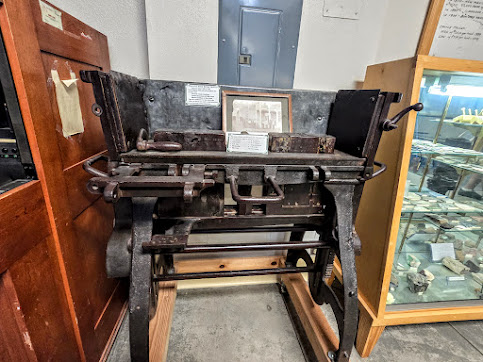














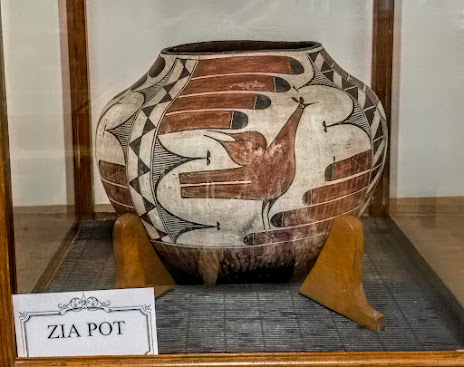





































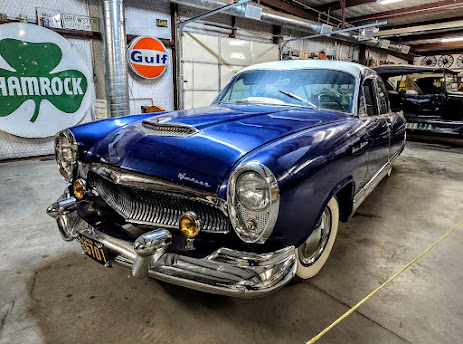


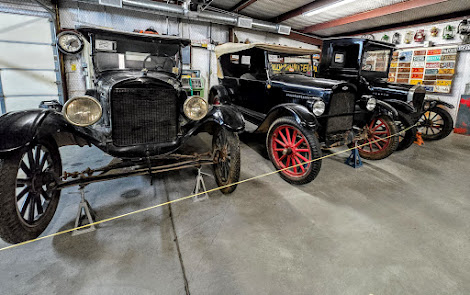




























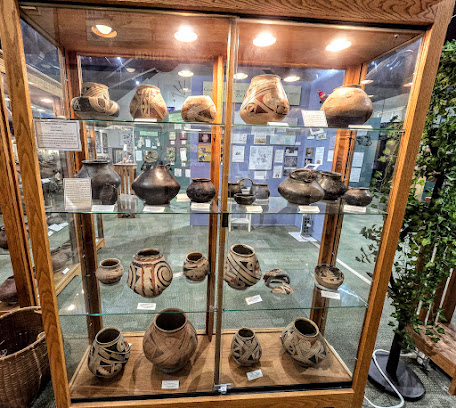







































No comments:
Post a Comment